Barcelona are currently in crisis mode. Everything around the club, from the coach and the quality of the squad, seems to be collapsing. The La Liga giants are stumbling and it might take a gigantic effort to get them back to the top, challenging rivals like Real Madrid once more.
However, in their moments of despair, as is the tradition at the club, the youth might provide an answer. Barcelona’s woes in the backline have been apparent for some time and unable to find or simply acquire suitable reinforcements in the market could encourage them to look within.
This tactical analysis will provide you with a scout report on Mika Marmol, a LaMasia centre-back who could grow into a player Barcelona’s first-team might need. The analysis will address his suitability to the club’s tactics as well as his strengths and weaknesses.
Player profile
Standing at 5ft 93in (1.81m) and weighing just 70kgs, Màrmol is far from an imposing centre-back figure. But what he lacks in brute strength and physical performance, he makes up in technical ability, positional awareness and work-rate. The 20-year-old defender is a versatile and above all, reliable option in the backline as he has played 100% of the available minutes in 2021/22, starting and finishing all six of Barcelona B’s games.
Below, we can see his player profile, as shown through the data for last season when he played a total of 2060 minutes across 26 games.
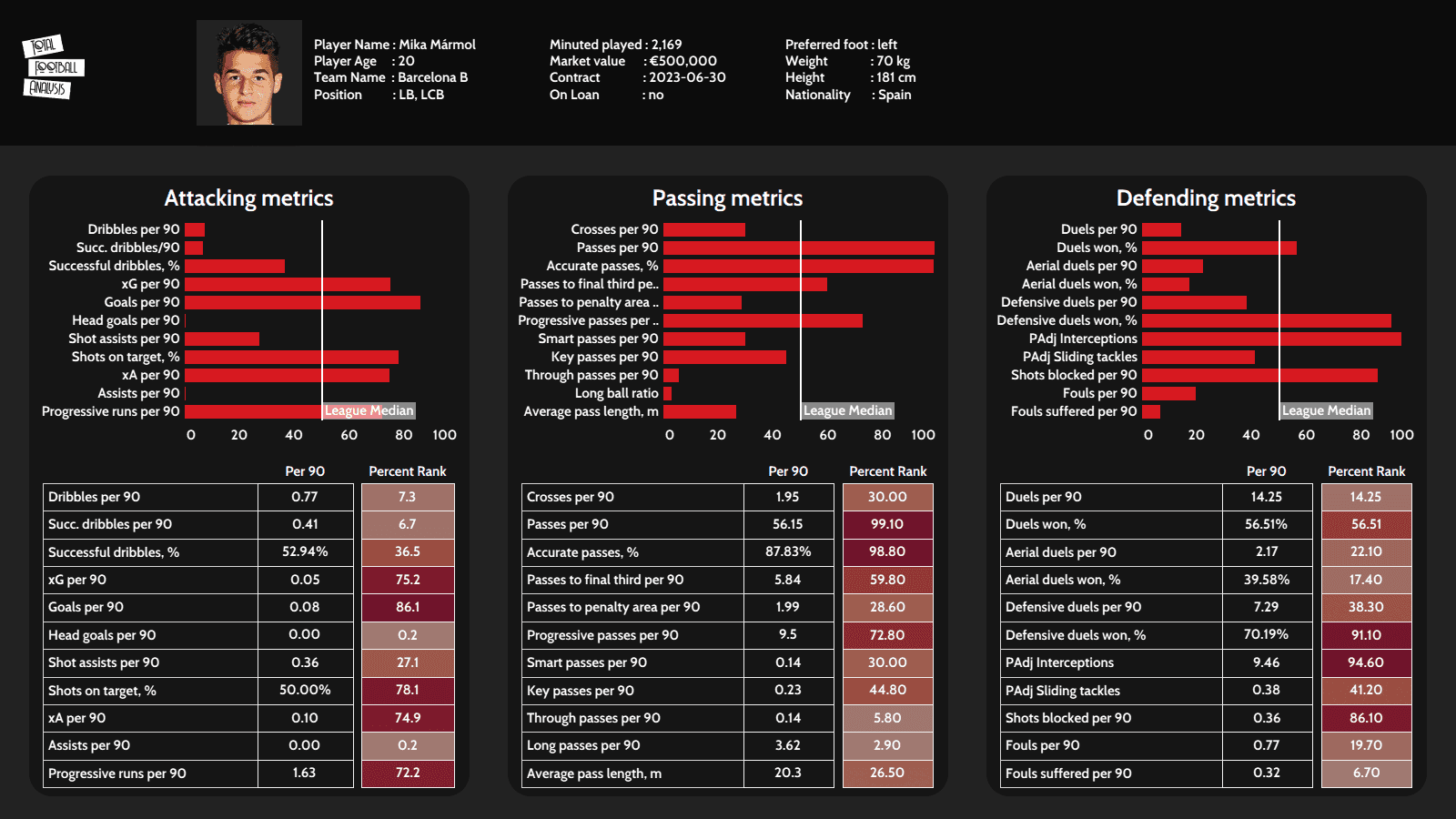
Màrmol is a true LaMasia graduate as his on-the-ball ability suggests. The data confirms what the eye-test had already concluded – the centre-back is a proficient progressor with confidence and skill in possession. Màrmol can run with the ball and even break lines with passes that find their targets in favourable positions.
Defensively, he is not the most powerful but he reads the game well, aggressively stepping out of his position to nullify opposition attacks. Màrmol lacks pure strength but is quick and agile for a centre-back, which can be used to his advantage. Similarly, he’s able to at play left-back and provide width and acceleration followed by accurate crosses too.
Passing and progressive runs
One of Màrmol’s greatest strengths certainly lies in his on-the-ball ability, as already alluded to in this scout report. The 20-year-old centre-back is a left-footer, meaning he could become a commodity in world football if he develops properly. Barcelona are lacking in the centre-back compartment since despite having a certain amount of depth, they are still missing quality personnel.
A left-footed centre-back is precisely what they would need. Both Clément Lenglet and Samuel Umtiti cannot be relied upon for various reasons so this could indeed be an opening for Màrmol. Below we can see his last four pass maps that will tell us a bit more about his tendencies in possession.
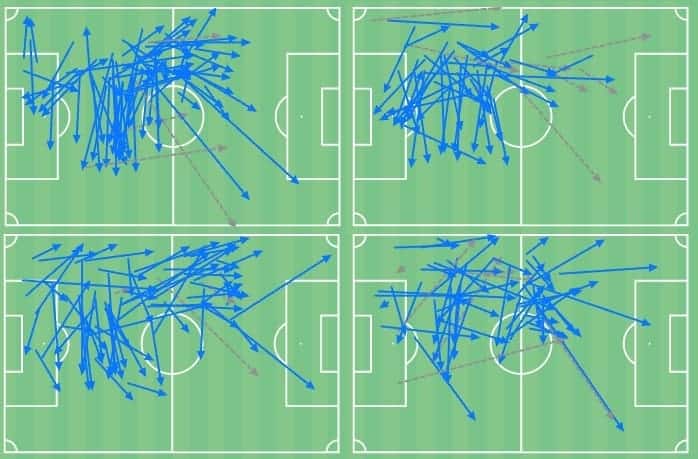
Due to Barcelona B largely enjoying the same tactics and philosophy as the first team, the centre-backs are seeing a lot of the ball at all times. Màrmol is very comfortable recycling possession and waiting for openings, which can sometimes make an impression of a very risk-averse passer.
While true to a certain extent, the young defender is still a progressive force for the squad, as can also be seen from the graph. He times his passes well and can break lines following great runs with the ball or just by opening his body and taking advantage of being a left-footed centre-back playing on the left side of the pitch.
This lets him angle his body to fully exploit open channels and progress the ball cleanly. Notice how he does that in the example below.
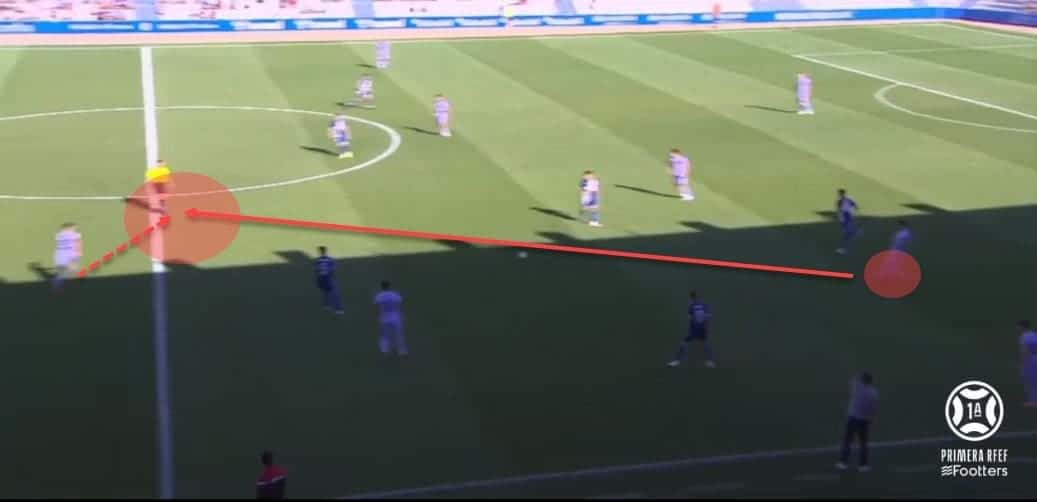
But the thing to note here is not only the ability to break lines but also to recognise the space where the play, or rather the ball, needs to go. Màrmol sees his teammate arriving from the left side of the pitch and instead of sending the ball to feet, he deploys it towards where the action is going to go next.
This reading of the game is crucial in both his on and off the ball abilities as it helps him get the best out of his teammates while also stopping opposition plays before they even properly begin. But a very common move Màrmol likes to do is running with the ball and then combining with his teammates higher up the pitch.
Take this sequence as an example. As soon as he recognises there is enough space for him to run into, the 20-year-old will advance with the ball until a good opening presents itself.
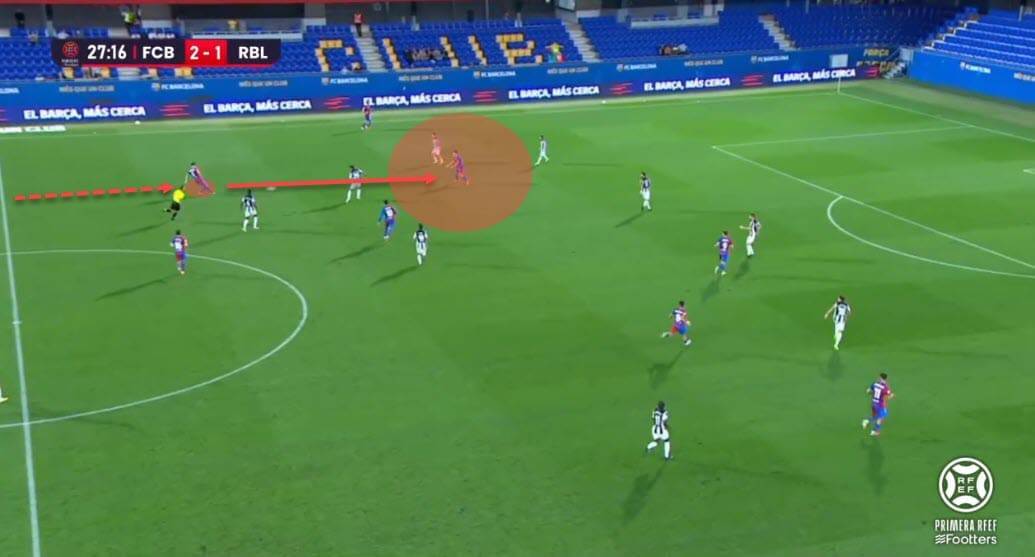
Not only does he conquer territory in that play but he also breaks the lines immediately after by deploying a good mid-range pass to a teammate in a danger area of the pitch. This skill is invaluable for Barcelona’s tactics as they need their centre-backs to be venturous and brave in possession.
And once again, just the fact he’s left-footed means he can angle his body that way to access the left half-space much easier in this situation. The most important thing is that this is not an isolated case either, Màrmol does this very often.
Our next example is very similar to the one before. The young centre-back runs into space that’s unoccupied by the opposition and then breaks lines with a fine diagonal pass between two markers.
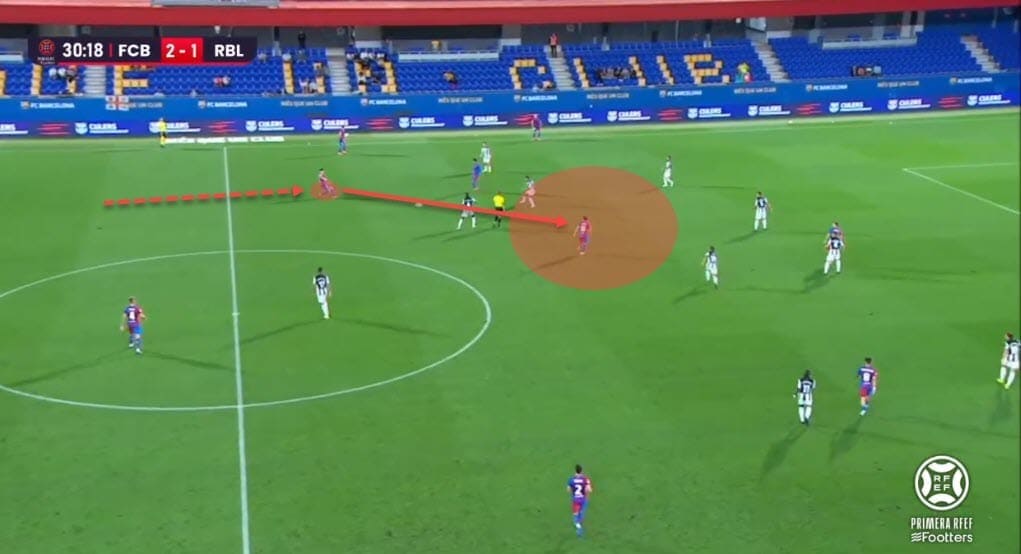
But what makes this very effective is that it doesn’t depend on Màrmol being marked or blocked by other players. He has the pace and the technical quality to beat markers and then advance into space that he’s essentially creating through his movement. Let’s explore that in our following play.
Here we have Màrmol advancing with the ball once again, only this time, in order to access the danger area behind the defensive block, he first has to beat the marker and then combine with his teammate.
He does exactly that and then sends a short-range pass while still advancing up the pitch to potentially be a part of the attacking sequence that unfolds.
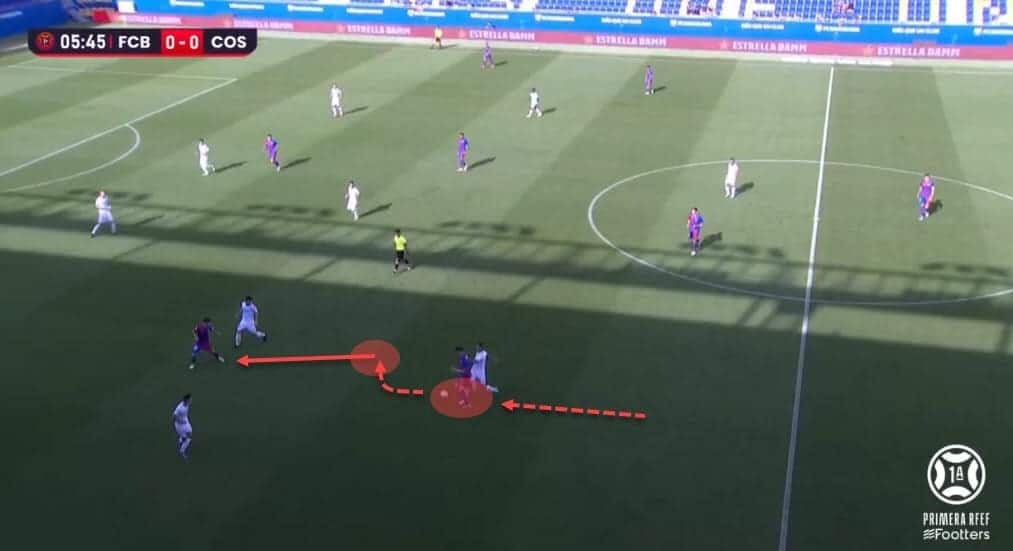
This is a trait of a very aggressive and proactive centre-back who is willing to do a lot of work both on and off the ball. Interestingly, Barcelona are a team that loves to have such profiles in their squad but are also not blessed with left-footed centre-backs who fit that certain mould of players.
Màrmol could offer them an interesting alternative to finding someone like that in the market.
Defensive contribution
We’ve already touched upon Màrmol’s physique, which is not exactly imposing for a tall centre-back. The truth is that this can be an issue in situations where he’s easily brushed off the ball or just pushed aside in a heated defensive duel.
However, the 20-year-old has the necessary recovery pace and reads the game very well, both of which helps him snuff out opposition attacks in such a way tackling is often either unnecessary or just plain easier. But firstly, let’s look at his last four duel maps, including attacking and defensive challenges on the pitch.
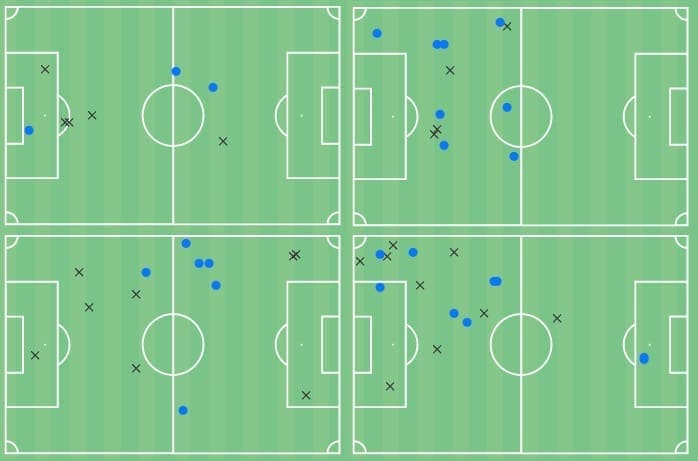
What you can instantly notice is the fact that Màrmol is very aggressive in his approach. The fact that a centre-back attempts so many duels so high up the pitch is telling enough and fortunately, he is confident and successful enough to warrant such an approach.
The attacking duels that can be seen high up are the result of his progressive runs into space and past markers while high defensive duels come after his aggressive exits and tight man-marking. This is a big trait of his defensive contribution. Màrmol is a willing and eager defender and in most scenarios, this aids and helps his cause.
Below, for example, he reads the game well and reacts in time to stop an opponent from getting into a dangerous situation. His quick decision-making and reaction time mean Barcelona B stop the attack and they get to restart their sequence shortly after.
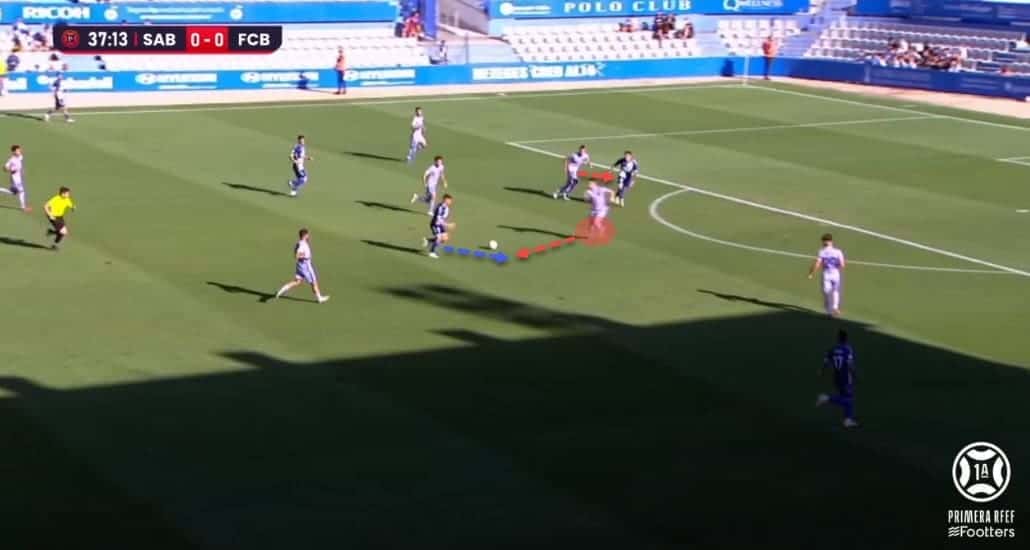
Similarly, when facing off directly against a striker, Màrmol is quick enough to recover the ball despite the opponent potentially having a head start. We can see that in the following image where the opposition is trying to play a ball over the top and behind Barcelona’s defensive line.
However, Màrmol is alert and ready to pounce, keeping up with the striker and eventually getting the ball and stopping the attack. This means that even if he misjudges a situation, he can still use his pace to backtrack and potentially rectify his own mistake.
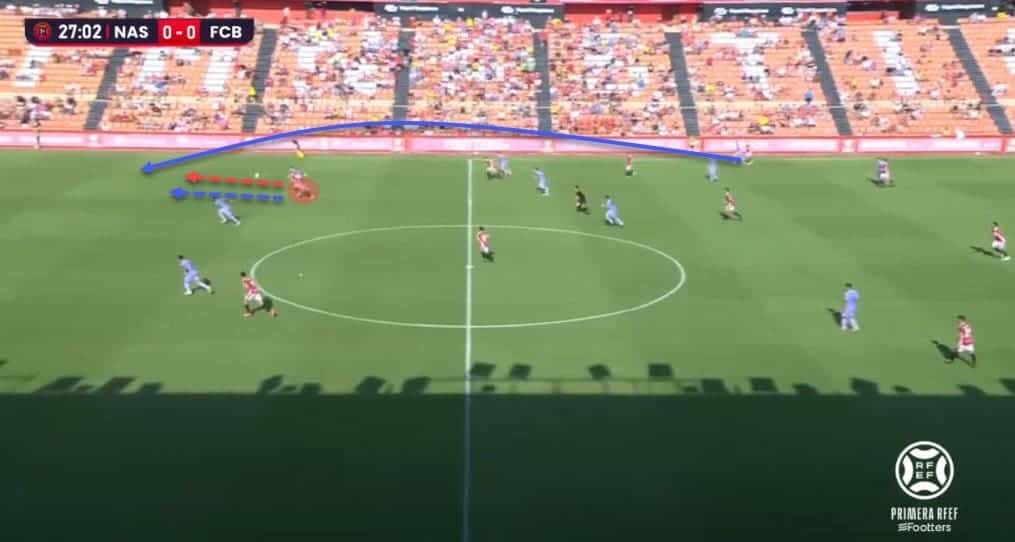
The issue is that his judgement is not always on point, which is somewhat to be expected from a 20-year-old defender with not much experience at the highest level of competition at all. This is most visible in his moments of aggression when he has to quickly decide whether to rush out or to hold his position and cover the area he’s currently occupying.
The next couple of examples will show us these instances in more detail. The first one just depicts Màrmol rushing in to face an opponent who’s entering a dangerous zone, just as he usually does, but fails to coordinate this with the rest of the team, leaving a huge pocket of space behind his back in the process.
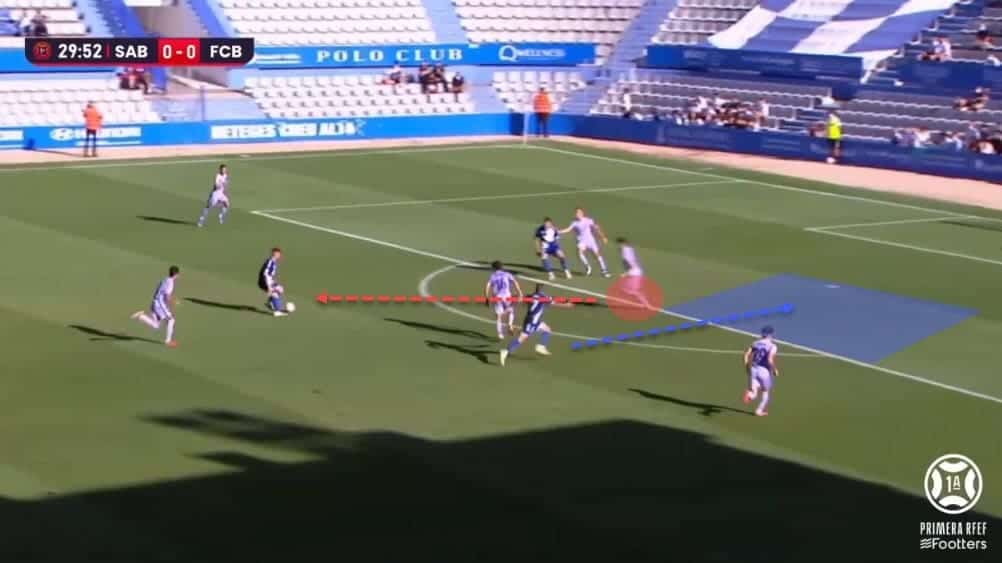
While this is something the whole defence has to work together on, it’s still his decision to move so far away from his initial position, risking a dangerous pass into the box by the opposition. In these situations, his teammates have to be ready to plug all potential holes once another defender rushes out to confront the attacker, which unfortunately doesn’t happen here.
And while this can go down as a mistake in the defensive setup as a whole, since that aggression is a very prominent trait of his, he needs to master it fully. Let’s look at another example that shows us a very similar scenario, this time much higher up the pitch.
Here, the opposition is transitioning into attack and Màrmol is once again rushing in, attempting to immediately stop the counter-attack.
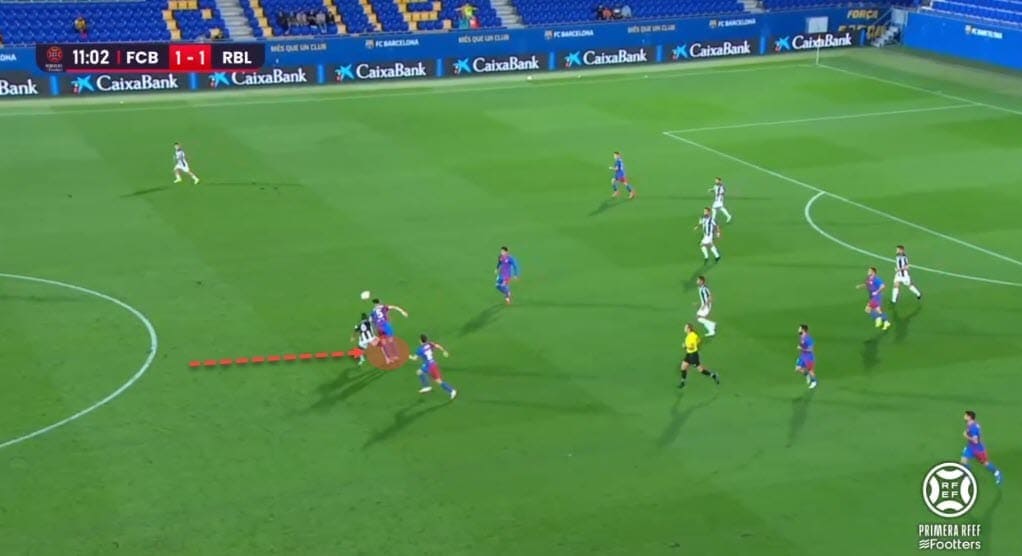
In essence, this is what Barcelona defenders are usually instructed to do. Most of their centre-backs will aggressively exit their areas to quickly snuff out attacks and employ effective counter-pressing. However, this is a skill that takes time to develop.
Màrmol steps out aggressively but this makes him mistime his jump and the opponent can break free so the young defender has to foul him to stop the action from unfolding. While he is a good defender who will likely become even better with time, he can sometimes lose these 1v1 duels that the team can’t afford to lose.
We see the same thing when looking at the duel map more closely. It seems that he’s shaky around the edge of the box and that can spell trouble for Barcelona.
Attacking contribution
The final attribute we’re going to discuss in this tactical analysis is Màrmol’s attacking contribution. Since he’s also able to play at left-back, the 20-year-old is used to appearing in the more advanced areas of the pitch, which can be seen from his 2020/21 heatmap down below.
We’re using the heatmap from last season because so far in 2021/22, he’s been exclusively played as a centre-back, thus somewhat limiting his creative and attacking output.
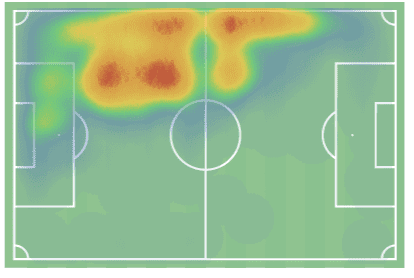
However, when given the space and freedom to roam up the pitch, Màrmol will gladly take it, as we’ve also seen with his progressive runs on the ball. But even more impressively, he will use his dribbling and pace to beat markers and set up his teammates, as well as make excellent overlapping runs into open space and even the opposition’s penalty area.
In the next example, we can see him use his pace to exploit the channels left open by the opposition. This is also where his dribbles really come in handy but if he sees open space in front of him, Màrmol is not afraid to use it to create advantages.
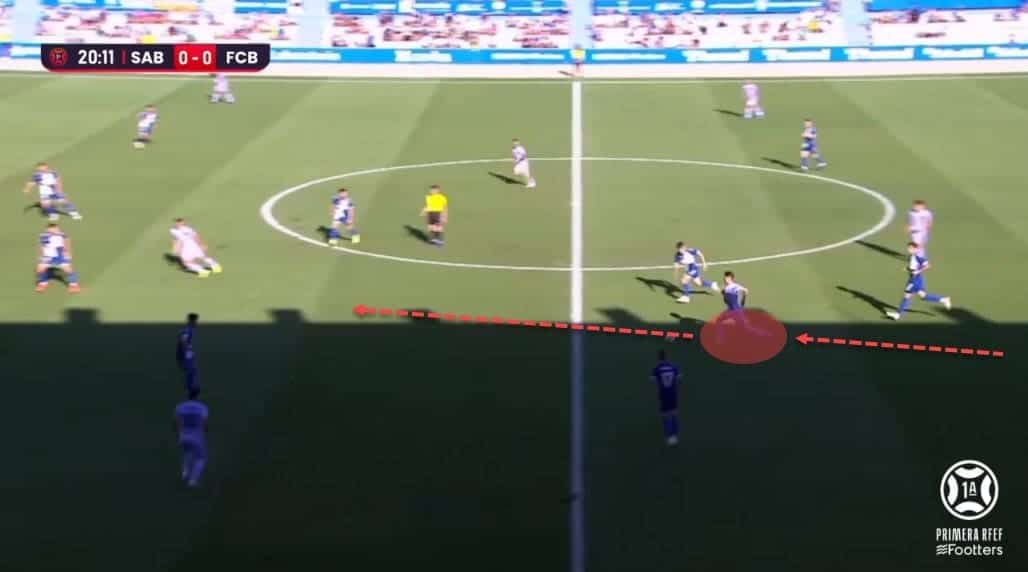
But these are scenarios in which he’s even encouraged to dribble and recognising such situations is key for an aggressive centre-back. If he misjudges an opportunity and makes a big mistake, it usually means at least one area of the defensive line is left exposed.
Màrmol likes to dribble and engage in offensive duels. That much we’ve seen from the initial duel map from our last section. However, sometimes he makes the wrong call of attempting a dribble in a risky area of the pitch, such as in and around his penalty box. Many of these failed attempts can lead to dangerous opportunities for the opposition so this is something to keep in mind for the future.
Playing for the first-team would require a lot more composure and better judgement.
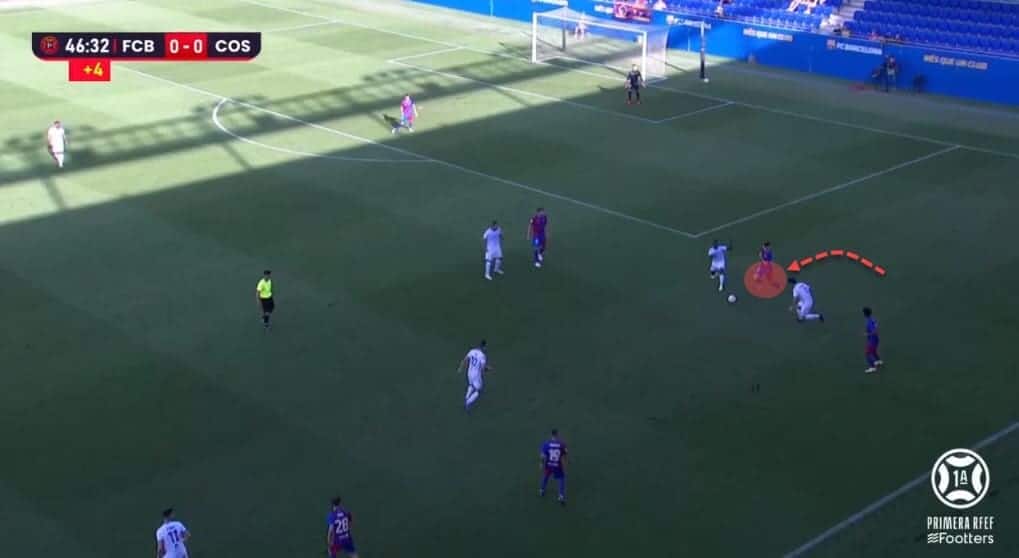
Of course, not all creativeness should be constrained but there is a time and a place for everything. Barcelona centre-backs are often technically good enough to attempt such moves and still get away with it so such scenarios are not as rare as one might think.
But Màrmol’s dribbling and pace are much better utilised further up the pitch and in transitional sequences, such as the one below. Here, we see the young defender overlap on the left and upon reaching the box, he deploys a cross towards the centre of the penalty area.
In this scenario, that ball doesn’t find its target but it still serves the purpose of highlighting another trait of his.
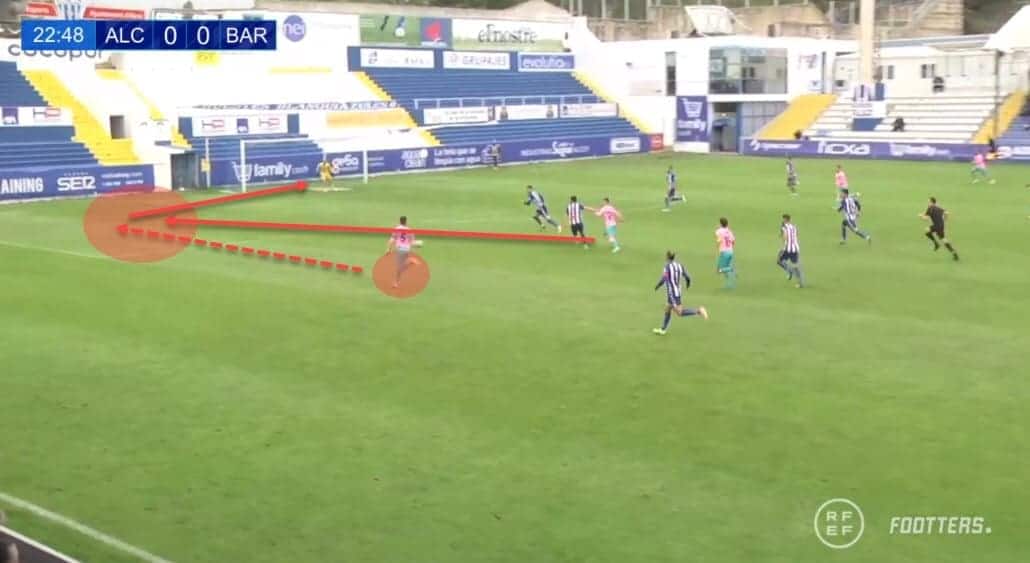
Conclusion
Mika Màrmol is far from a finished product and it will probably take him more time to finally reach the first team, if he does at all. However, there is no denying his talent and potential.
Màrmol does the basic stuff well and clean while he’s also capable of doing exactly what Barcelona need their centre-backs to do. Once he improves on some of his shortcomings, there could indeed be a spot for him in the senior squad.






Comments